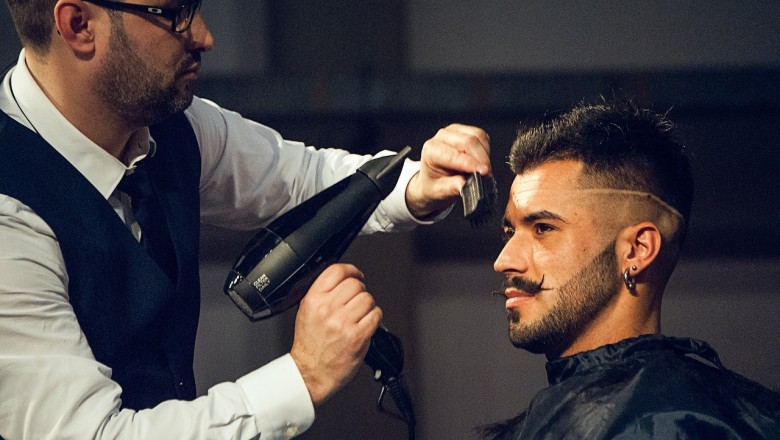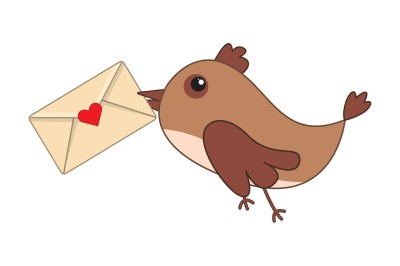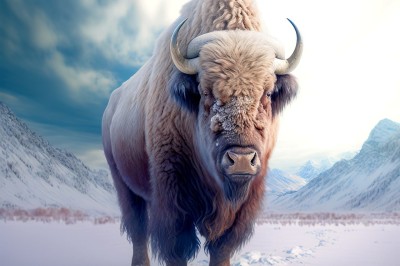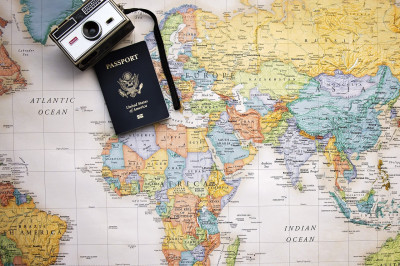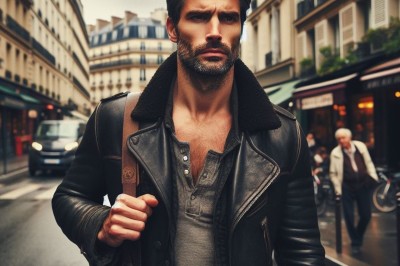Understanding Taper Fade Haircuts
Taper fade haircuts have become a cornerstone in men's hairstyling, offering a versatile and sharp look that suits a wide array of personal styles and preferences. The defining characteristic of the taper fade is the gradual transition of hair length from the top of the head down to the nape of the neck and sides. This blend can vary from subtle to dramatic, depending on the desired effect.
The Basics of the Taper Fade
At its core, the taper fade starts with longer hair at the top of the head, which progressively becomes shorter as it moves down toward the neck. Barbers achieve this effect using clippers with different guard sizes to create a "fade" of hair lengths. The taper can end at various points on the head, often above the natural hairline around the ears and at the nape of the neck.
Variations of the Style
The taper fade is not a one-size-fits-all haircut. It comes in several variations, each with its own unique appeal:
The Classic Taper Fade
This version maintains a more traditional and subtle look, with the hair gradually shortening but not down to the skin. It's a timeless choice that's perfect for professional settings.
The Low Fade
In a low fade, the shortest part of the hair is around the ear level, offering a conservative fade that's not too stark. It's an excellent option for those new to fade haircuts.
The Mid Fade
A mid fade offers a balanced look, starting halfway up the sides and back of the head. It's a modern style that's both noticeable and not too extreme.
The High Fade
For a bolder statement, the high fade begins much higher on the head, often near the temples. This style is more dramatic and stands out more than the lower variations.
The Skin or Bald Fade
The most striking variation, the skin or bald fade, involves shaving down to the skin at the lowest part of the haircut. It requires more frequent maintenance but offers a clean and high-contrast look.
The Taper Fade's Popularity
The taper fade's popularity lies in its adaptability. It can be combined with a variety of hair textures and lengths on top, from short buzz cuts to longer, textured styles. This haircut is favored by those who want a clean-cut appearance that is both stylish and easy to maintain.
Customization and Personalization
One of the reasons the taper fade remains a staple in hairstyling is its ability to be customized. Barbers can adjust the angle and length of the fade to flatter different head shapes and hair types. Personal touches, such as a hard part line or hair designs, can also be incorporated for an individualized look.
Maintenance and Upkeep
While taper fades do require regular upkeep to maintain their crisp appearance, the frequency of visits to the barber can vary based on the speed of hair growth and the precision of the fade. Generally, a touch-up every few weeks keeps the style looking fresh.
The taper fade haircut is a dynamic and enduring style that continues to evolve while maintaining its status as a go-to choice for men around the world. Its ability to be tailored to the individual makes it a versatile option for anyone looking to update their look with a haircut that's both classic and contemporary.
The History and Evolution of the Taper FadeOrigins of the Taper Fade
The taper fade haircut has its roots in the military, where short haircuts have long been a requirement for soldiers for both practicality and uniformity. The style began to gain civilian popularity in the United States during the 1940s and 1950s, particularly among African American communities. It was a time when sharp, clean lines and precise grooming started to symbolize a sense of pride and self-care.
Rise in Popularity
In the 1980s and 1990s, the taper fade became a staple in the hip-hop and African American communities, with icons like Will Smith and Tupac Shakur sporting the style. It was during this era that the haircut began to be associated with the cultural movements of the time, symbolizing a blend of style consciousness and a nod to cultural roots.
Variations and Innovations
As the taper fade grew in popularity, barbers began to experiment with different gradients and techniques, leading to a variety of styles within the taper fade category. The high top fade, for example, became a signature look of the late '80s and early '90s, characterized by a flat top and sharp fade. The low fade offered a more subtle take on the style, while the mid fade struck a balance between the two.
Influence of Celebrity and Fashion
Celebrities and athletes have played a significant role in the evolution of the taper fade. With each public figure that chooses the style, a new variation often emerges, influenced by their personal taste and the skill of their barber. This has led to the taper fade becoming a canvas for personal expression and a reflection of individual style.
Global Adoption and Adaptation
The taper fade has transcended its origins and has been adopted by various cultures around the world. It has been adapted to suit different hair types and face shapes, making it a versatile choice for many. The style's ability to blend with other haircuts, like the pompadour or the mohawk, has also contributed to its global appeal.
Technological Advancements in Barbering
With the advancement of barbering tools and techniques, the precision and artistry involved in creating a taper fade have reached new heights. Clippers with adjustable blades, specialized guards, and even laser-guided tools have allowed barbers to create incredibly detailed and consistent fades. This technological progression has kept the taper fade at the forefront of men's hairstyling trends.
The Taper Fade in Modern Culture
Today, the taper fade is more than just a haircut; it's a statement. It has been embraced by a diverse range of subcultures and professions, from corporate offices to the fashion runways. The modern taper fade can be customized with designs, partings, and even color to create a unique look that is both contemporary and timeless. As a result, the taper fade remains a style staple that continues to evolve while maintaining its classic roots.
Different Types of Taper Fade HaircutsClassic Taper Fade
The classic taper fade haircut is a timeless style where the hair gradually shortens from the top down to the sides and back. It begins with a longer length on top and tapers to a shorter length near the neckline. The fade can be adjusted to be high, medium, or low, depending on personal preference, with the hair above the fade line left longer for styling.
Low Taper Fade
A low taper fade starts just above the ears and curves around the head, blending into the skin at the very bottom near the hairline. This type of fade is subtle and is a great choice for those who want a clean-cut look without a stark contrast between the lengths of hair.
High Taper Fade
In contrast to the low taper fade, the high taper fade begins much higher up on the head, often near the temples. This creates a more dramatic look as there is a more noticeable difference between the lengths of hair on the top of the head and the faded sides.
Mid Taper Fade
The mid taper fade strikes a balance between the high and low fades. It starts around the middle of the head, offering a versatile look that is not too extreme but still provides a noticeable gradient effect.
Skin or Bald Taper Fade
The skin or bald taper fade takes the fade down to the skin, resulting in a very clean and sharp appearance. The hair is faded until it completely blends into the skin, usually starting at a higher point on the head to accentuate the fade.
Temple Fade
Also known as a temp fade, the temple fade focuses on the temples, with the fade beginning at this point and often extending to the sides of the head. It's a popular choice for adding a modern twist to the taper fade style.
Scissor Taper Fade
For those who prefer a more textured and less machine-like finish, the scissor taper fade is cut using scissors instead of clippers. This technique allows for a softer, more natural transition between hair lengths.
Taper Fade with Part
Adding a hard part to a taper fade haircut can create a more structured and defined look. The part is usually a clean line shaved into the hair that separates the top from the faded sides, adding an extra element of style to the classic taper fade.
Taper Fade with Design
For a more personalized touch, some opt for a taper fade with a design. This involves shaving patterns or shapes into the faded area, allowing for a creative and unique expression of style.
Curly Taper Fade
Those with curly hair can also enjoy a taper fade haircut. The curly taper fade works with the hair's natural texture, starting with longer curls on top that gradually fade into shorter lengths on the sides and back.
Taper Fade with Beard
A taper fade can be seamlessly integrated with facial hair. The fade can be designed to gradually blend into the beard, creating a cohesive look that connects the haircut with the beard line.
Undercut Taper Fade
The undercut taper fade combines the distinct look of an undercut with the gradual fade of a taper. The top section of hair is left longer and disconnected from the faded sides, resulting in a high-contrast style that is both edgy and fashionable.
How to Choose the Right Taper Fade for Your Face ShapeUnderstanding Face Shapes
Before selecting a taper fade, it's essential to understand the different face shapes and their characteristics. The primary face shapes include oval, square, round, diamond, heart, and oblong. Each shape has distinct features that can be accentuated or balanced with the right haircut.
Oval Face Shape
An oval face shape is considered the most versatile for hairstyles, including taper fades. The face is longer than it is wide, with a rounded jawline. For this shape, most taper fades work well, but a classic taper fade with a longer top can highlight the face's symmetry without making it appear longer.
Square Face Shape
Square faces have a strong jawline and broad forehead, creating an angular appearance. A taper fade with a bit more length on top can soften these angles. Opt for a low to mid taper fade to maintain the square shape's masculine features without overemphasizing the jawline.
Round Face Shape
Round faces are characterized by equal width and length with soft edges. A high taper fade can elongate the face, giving it a more oval appearance. Keeping the hair shorter on the sides and adding volume on top can create the illusion of a more angular face.
Diamond Face Shape
Diamond-shaped faces have wide cheekbones, a narrow forehead, and a narrow chin. A low taper fade that maintains some length on the sides can help to balance the cheekbones. A textured top can add width to the forehead and chin, harmonizing the overall face shape.
Heart Face Shape
Heart-shaped faces have a wide forehead and cheekbones with a narrow chin. A mid to low taper fade can minimize the width of the forehead, and a fringe or bangs can also help to balance the face. Avoid high fades, as they can accentuate the width of the forehead and the narrowness of the chin.
Oblong Face Shape
Oblong faces are longer and may appear more rectangular. A taper fade with volume on the sides can help to make the face appear fuller and more balanced. Avoid taking the fade too high, as this can further elongate the face. Instead, focus on a balanced style that adds width.
Personal Style and Hair Texture
Beyond face shape, consider personal style and hair texture. A taper fade should complement not only your face but also your lifestyle and the amount of time you're willing to invest in styling. Additionally, hair texture can influence the taper fade's appearance, so work with your natural hair type for the best results.
Consulting with a Professional
When in doubt, consult with a professional barber or stylist. They can provide personalized advice based on your face shape, hair texture, and style preferences. A skilled barber will be able to tailor a taper fade that suits your individual features and gives you a sharp, on-trend look.
The Process: What to Expect When Getting a Taper FadeConsultation with Your Barber or Stylist
When you arrive at the barbershop or salon, the process begins with a consultation. Your barber or stylist will discuss your desired length, the gradient of the fade, and any specific variations you want. This is the time to mention if you prefer a low, mid, or high taper fade, and whether you want a skin fade or one that leaves some hair length.
Preparing Your Hair
Before starting the cut, your hair will be washed and dried if necessary, to ensure it's clean and manageable. This step is crucial for a precise cut, as oily or tangled hair can obstruct the cutting process.
The Initial Haircut
Your barber will start by cutting the top of your hair to the desired length using scissors or clippers with a guard. This sets the stage for the taper fade, as the contrast between the top and the sides is a defining characteristic of the style.
Crafting the Taper Fade
The taper fade process begins with the barber selecting the appropriate guard size to start blending the hair. They will work around your head, methodically reducing the guard size to create a gradual fade. The barber may use clipper-over-comb techniques or freehand clipper work to achieve a seamless blend.
Defining the Fade
As the fade takes shape, the barber will pay close attention to the areas around the ears and back of the neck, ensuring a smooth transition. They will use trimmers to create a clean line around the edges of your hairline, which is known as edging or outlining.
Detailing and Refinement
Once the basic shape of the taper fade is established, the barber will refine the haircut. This involves going over the fade again to remove any remaining bulk and to ensure a smooth gradient. The barber may use a straight razor or foil shaver to achieve a closer shave around the lower parts of the fade for a sharper look.
Styling the Final Look
After the haircut is complete, the barber will style your hair. They may apply products like pomades, gels, or waxes to achieve the desired look. This is also an opportunity for you to learn how to style your new taper fade at home.
Maintenance Tips
Before you leave, your barber will provide you with maintenance tips to keep your taper fade looking sharp. They will advise you on how often you should return for touch-ups and recommend styling products to use at home.
Maintenance Tips for Keeping Your Taper Fade SharpSchedule Regular Touch-Ups
To maintain the sharpness of a taper fade haircut, it's essential to schedule regular touch-ups with your barber. The frequency of these visits can depend on how quickly your hair grows and how pristine you want your fade to look. Typically, a touch-up every 2-3 weeks will keep your fade looking fresh and well-defined.
Invest in Quality Hair Care Products
Using the right hair care products is crucial for maintaining the look of your taper fade. A good pomade, wax, or gel can help you style your hair and keep it in place throughout the day. Look for products that provide a strong hold without leaving residue or causing flakiness.
Wash and Condition Your Hair Properly
Keeping your hair clean and well-conditioned is important for the overall health of your hair and scalp. Use a gentle shampoo to avoid stripping your hair of its natural oils, and follow up with a conditioner that suits your hair type. This will help your hair look its best and make styling easier.
Learn Basic Styling Techniques
Understanding how to style your taper fade can make a big difference in how sharp it looks day-to-day. Ask your barber for tips on how to style your hair at home, including which direction to comb and how to apply styling products effectively.
Protect Your Hair While Sleeping
To prevent your taper fade from getting messy while you sleep, consider wearing a durag or a silk cap. This can help to keep your hair in place and reduce the need for extensive styling in the morning.
Keep Your Hair and Scalp Healthy
A healthy scalp promotes healthy hair growth, which is essential for maintaining a sharp taper fade. Regularly exfoliate your scalp to remove dead skin cells and product buildup. Also, ensure you're eating a balanced diet and staying hydrated to support hair health from the inside out.
Be Mindful of the Sun
Excessive sun exposure can damage your hair, leading to dryness and color fading. When spending time outdoors, wear a hat to protect your hair from the sun's harmful UV rays.
Use the Right Tools for At-Home Maintenance
If you're comfortable with doing some at-home maintenance, invest in a quality set of hair clippers with various guard sizes. This will allow you to clean up your neckline and around your ears between barber visits. However, be cautious and start with longer guards to avoid cutting too much off.
Stay Consistent with Your Barber
Consistency is key when it comes to maintaining a taper fade. Stick with the same barber who is familiar with your hair and how you like your fade. This ensures that each touch-up is consistent with the last, maintaining the sharpness of your haircut.
By following these maintenance tips, you can keep your taper fade looking sharp and stylish, ensuring that this classic haircut remains a staple of your personal style.
Styling Your Taper Fade: Products and TechniquesChoosing the Right Styling ProductsPomades
Pomades are ideal for achieving a sleek, shiny look with your taper fade. They come in water-based and oil-based varieties. Water-based pomades offer a strong hold with a cleaner finish and are easier to wash out, while oil-based pomades provide a tighter grip on your hair for a glossier appearance.
Waxes and Clays
Waxes and clays are perfect for those seeking a matte finish with a strong hold. They are excellent for adding texture and volume to the hair on top, which can complement the sharpness of the taper fade.
Gels and Creams
Gels are great for a wet look and a very firm hold, but they can flake and harden. Hair creams, on the other hand, offer a lighter hold and can be used to create a natural, effortless style that moves freely.
Hairsprays
Hairsprays are used as a finishing touch to hold the style in place. They come in various strengths and can be used to maintain the volume or to tame flyaways without making the hair too stiff.
Mastering the TechniqueApplying Product
Start with a small amount of product, warming it up between your palms before applying it to your hair. Begin at the back and work your way to the front, ensuring even distribution. For a more textured look, use your fingertips to twist and tousle the hair.
Creating Volume
To add volume, especially to the hair on top, use a blow dryer while lifting the hair with a round brush or your fingers. Direct the airflow from the roots upwards to achieve the desired height and fullness.
Defining the Fade
Use a fine-tooth comb to define the lines of your taper fade. For a sharper look, apply a small amount of product on the comb and run it along the edges of the fade to clean up any stray hairs.
Maintaining the Look
Throughout the day, you may need to touch up your style. Keep a small amount of your chosen styling product with you for quick fixes. Remember that less is more; you don't want to weigh down your hair with too much product.
Tailoring to Hair Type
Consider your hair type when styling your taper fade. Curly or wavy hair may require a cream or pomade to define the curls, while straight hair might benefit from wax or clay to add texture. Always choose products that work with your hair's natural tendencies.
By selecting the right products and mastering these techniques, you can ensure your taper fade looks sharp and stylish all day long.
Taper Fade Haircuts in Popular Culture and FashionThe Rise of the Taper Fade in Hip-Hop and Sports
The taper fade haircut has been a significant style in hip-hop culture since the 1980s. It gained popularity among artists and fans alike for its clean lines and stylish edge. Icons like Big Daddy Kane and Kid 'n Play were among the early adopters, showcasing high top fades that evolved into the taper fade styles we see today. In the sports world, athletes like Michael Jordan and Allen Iverson have sported variations of the taper fade, influencing young fans and aspiring sports stars to adopt the look.
Hollywood's Embrace of the Taper Fade
Hollywood has also played a role in popularizing the taper fade haircut. Celebrities like Brad Pitt, David Beckham, and Zac Efron have been seen with this versatile haircut on the red carpet and in their films. The style's adaptability for different hair types and face shapes has made it a go-to look for stylists in the entertainment industry.
Fashion Industry and Runway Trends
In the fashion industry, the taper fade has been embraced for its modern and clean aesthetic. Designers often style their male models with taper fades to convey a sharp and contemporary image. The haircut's ability to blend with various fashion trends, from streetwear to formal attire, makes it a staple on runways around the world.
Influence of Social Media and Influencers
Social media influencers and fashion bloggers have also contributed to the taper fade's popularity. Platforms like Instagram and YouTube are filled with tutorials and style inspiration, making it easier for people to learn about the haircut and how to style it. Influencers often collaborate with barbers and hairstylists to showcase the versatility of the taper fade, further cementing its status in popular culture.
The Taper Fade in Music Videos and Album Art
Music videos have always been a showcase for cutting-edge fashion and style. The taper fade haircut is often featured in these visual spectacles, sported by artists across various genres, from hip-hop to pop. Album art, too, sometimes highlights the artist's hairstyle, with the taper fade being a frequent choice due to its striking and recognizable silhouette.
The Role of Celebrity Barbers
Celebrity barbers have become stars in their own right, with some gaining fame for their signature taper fade cuts. These barbers often share their work on social media and are featured in magazines, further influencing the popularity of the style. Their clientele, often consisting of actors, musicians, and athletes, serve as walking billboards for the taper fade haircut.
The Taper Fade Across Different Cultures
While the taper fade has roots in African American culture, it has crossed cultural boundaries and is now embraced by men of all ethnicities. The style's adaptability allows it to be customized to suit different hair textures and cultural aesthetics, making it a universal choice for a clean and stylish look.
The Evolution of the Taper Fade in Fashion Campaigns
Fashion campaigns have evolved to include more diverse and edgy looks, with the taper fade often at the forefront. Brands that cater to a younger, fashion-forward audience use models with taper fades to appeal to their demographic. The haircut's association with youth and trendiness makes it an ideal choice for campaigns aiming to project a modern and dynamic image.



